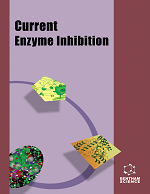- Home
- A-Z Publications
- Current Enzyme Inhibition
- Previous Issues
- Volume 1, Issue 2, 2005
Current Enzyme Inhibition - Volume 1, Issue 2, 2005
Volume 1, Issue 2, 2005
-
-
iNOS/COX-2 Pathway Interaction: A Good Molecular Target for Cancer Treatment
More LessAuthors: F. Cianchi, F. Perna and E. MasiniAn increase in the expression and activity of both inducible nitric oxide synthase (iNOS) and cyclooxygenase-2 (COX-2) has been shown in several types of human tumors. A large body of evidence has demonstrated that these two enzymes are involved in tumor progression through several molecular mechanisms, such as promotion of tumor cell proliferation, inhibition of apoptosis and stimulation of angiogenesis. iNOS and Read More
-
-
-
11β-Hydroxysteroid Dehydrogenase Type 1: A Potential Therapeutic Target for the Control of Local Glucocorticoid Concentrations
More LessChronically elevated glucocorticoid concentrations, either systemically or locally, are associated with adverse metabolic effects, including osteoporosis, Cushing's syndrome, obesity, dyslipidemia, type 2 diabetes, and cardiovascular disease. Elevated glucocorticoid levels impair insulin and leptin sensitivity, ultimately resulting in the development of the metabolic syndrome. β-hydroxysteroid dehydrogenase type 1 (β-HS Read More
-
-
-
Cellular and Biochemical Alterations Caused by Artificial Depletion of Glutathione
More LessAuthors: N. T. d. Talamoni, A. Marchionatti, G. Diaz de Barboza and A. PerezThis review will focus on glutathione depletion performed in different biological systems to elucidate molecular implications of this tripeptide on physiological and pathological processes. Cellular and molecular changes produced in liver, brain and kidney by glutathione depleting drugs, such as D,Lbuthionine- S,R-sulfoximine, menadione and acetaminophen, will be described. Special attention will be given to the inhibitory mec Read More
-
-
-
Arachidonic Acid Cascade Enzyme Inhibition and Cancer
More LessBy J. J. MorenoArachidonic acid (AA) metabolites are lipid signalling mediators that play a central role in a broad array of physiological and pathophysiological processes, including cell proliferation and differentiation. AA metabolism diverges into two main pathways, the cyclooxygenase (COX) pathway, which leads to prostaglandin and thromboxane production, and the lipoxygenase (LOX) pathway, which leads to the leukotriene and hydr Read More
-
-
-
Antioxidants as Potentially Safe Antidotes for Organophosphorus Poisoning
More LessOrganophosphorus (OP) compounds are extensively used in widespread applications, causing considerable poisonings around the world. Current treatments against poisoning by organophosphates, nerve agents, or other acetylcholinesterase (AChE) inhibitors are based on the intravenous or intramuscular administration of a muscarinic antagonist (atropine), a cholinesterase reactivator (an oxime), and an anticonvulsant (a be Read More
-
-
-
Proteolytic Enzymes and Their Inhibition in Epithelial Ovarian Cancer
More LessAuthors: A. M. Smedts, T. E. Curry Jr. and W. J. MurdochCommon (surface) epithelial cancer of the ovary is epitomized by metastasis to organs of the abdominal cavity. Proteolytic enzymes, predominately those of the matrix metalloproteinase and plasminogen activator-plasmin systems, have been implicated as mediators of tissue invasion. This review highlights the salient features of ovarian cancer progression, the proteases involved, and experimental approaches of inhibition. Read More
-
-
-
The Dilemma of Modern Functional Enzymology
More LessAuthors: Carsten Kettner and Martin G. HicksFunctional characterization of enzymes plays an essential role in one of the major areas of proteomics research: the modelling of sections of the cellular metabolism with a view to being able to model the whole cellular metabolism and the interaction of cells within tissues and organs. With these purposes in mind, the scientific community established a new branch within the life sciences, called systems biology. However, me Read More
-
-
-
Inhibitors of Protein Prenylation: An Overview
More LessAuthors: Saswati Banerjee and Paul McGeadyProtein prenylation is a type of lipid modification involving attachment of either a farnesyl (15- carbon) or geranylgeranyl (20-carbon) isoprenoid group via thioether linkages to the cysteine residues at or near the C-terminus of various eukaryotic proteins. According to their substrate specificity the three known types of prenyltransferases can be categorized in two classes: the farnesyltransferase and geranylgeranyltra Read More
-
Volumes & issues
-
Volume 20 (2024)
-
Volume 19 (2023)
-
Volume 18 (2022)
-
Volume 17 (2021)
-
Volume 16 (2020)
-
Volume 15 (2019)
-
Volume 14 (2018)
-
Volume 13 (2017)
-
Volume 12 (2016)
-
Volume 11 (2015)
-
Volume 10 (2014)
-
Volume 9 (2013)
-
Volume 8 (2012)
-
Volume 7 (2011)
-
Volume 6 (2010)
-
Volume 5 (2009)
-
Volume 4 (2008)
-
Volume 3 (2007)
-
Volume 2 (2006)
-
Volume 1 (2005)
Most Read This Month
Article
content/journals/cei
Journal
10
5
false
en


